The concept of Passive House, or energy efficient building, refers to a standard of construction of a home with the following features:
- Truly efficiency in energy consumption. Using the principles of bioclimatic architecture, to take advantage of the energy conditions of the environment and reduce consumption in all areas.
- Comfortable and comfortable. The energy efficiency does not decrease quality of life, on the contrary, it sets a base for an important increase in comfort and quality of use.
- Really affordable. Obtaining these advantages in our home is not something only available to a few, the cost of doing so is very low. Because what matters is how the building works are done, whilst the materials used are not more expensive than the traditional ones.
- Environment friendly. That is, in addition to energy efficiency, a Passive House is built respecting the environment and perfectly integrated with its surroundings.
In this way, a passive house is a home that makes minimal energy consumption while maintaining adequate air and water conditions throughout the year. In addition, its construction, design and layout are ecological, trying to minimize its carbon footprint and its impact on the environment.

Origin of Passive House
It is important to understand that Passive House is not a brand, but an efficient construction concept. This construction concept that appeared already in the early 80s.
Back then, there was already a talking about the use of bioclimatic architecture for home construction. In detail, the study of the climate of the area where the house was going to be built (taking into account sunny days, rain, the surrounding environment, etc.) was used to make the most of them with their orientation and design.
That, together with the use of materials and construction procedures as ecological and efficient as possible for that environment, results in a house with ultra-minimal energy consumption.
How much you save on energy consumption with a Passive House
The concept of passive house goes far beyond of what we usually consider when we talk, for example, about energy rating labels in buildings.
When the building process is done following Passive House standards, there are important energy savings, like:
- Up to 90% less heating resources, compared to a building that has followed traditional construction patterns.
- When it comes to new buildings, which have higher efficiency standards, the Passive House still offers up to 75% or more in energy savings.
- In the case of warmer areas, where the greatest energy expenditure is in cooling and not heating, similar data on consumption savings have also been verified.
Advantages of a Passive House
Taking it toegether, we can say that the advantages of this building system are:
- A radical reduction of the energy costs, which implies a saving in the short / medium term.
- Responsible energy consumption.
- A lower environmental impact in all stages of life of the passive house, from its construction to its years of useful use.
- Greater comfort, since it is not necessary to be constantly monitoring and adjusting the heating / cooling devices. The passive house becomes an environment with basic and constant conditions much more comfortable than any other type of house.
- Longer life and less expense on repairs and renovations. Since the passive house uses high-level and environmentally friendly materials, it lasts longer, does not require repairs often and there are no other problems arising from the use of low quality construction.
The international standards of the Passive House, its history and its expansion
In order for a house to be considered passive, it must meet the standards that arose following a collaboration between Wolfgang Feist, from the German Building and Environment Institute and Bo Adamson, from Lund University in Sweden.
The first house that met that standard was built in Darmstadt, Germany, in 1990. The Passivhaus-Institut would be born there, six years later, which controls that standard to get houses with that 90% reduction in energy consumption. Germany, Austria and the Nordic countries are the pioneers in Europe in terms of passive houses.
In the early 2000s, the Passive House concept crosses the ocean and the first passive house in the United States is built in Urbana, Illinois, in 2003.
Passivhaus-certified materials are marketed and, currently, due to the greater ecological awareness, the fight against climate change and the price of energy, the concept of passive house is more in vogue than ever.
As we can see, a good construction standard allows savings of up to 90% and total respect for the environment surrounding the house. Therefore, the Passive House concept will become increasingly important in a world of clean energy and responsible consumption.
Would like to see more projects or know more about us? Please click here
or contact us using the form bellow:

